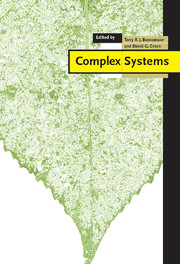Book contents
- Frontmatter
- Contents
- 1 Introduction
- 2 Self-organisation in complex systems
- 3 Network evolution and the emergence of structure
- 4 Artificial life: growing complex systems
- 5 Deterministic and random fractals
- 6 Non-linear dynamics
- 7 Non-linear control systems
- 8 Parallel computers and complex systems
- 9 Are ecosystems complex systems?
- 10 Complexity and neural networks
- Index
6 - Non-linear dynamics
Published online by Cambridge University Press: 04 August 2010
- Frontmatter
- Contents
- 1 Introduction
- 2 Self-organisation in complex systems
- 3 Network evolution and the emergence of structure
- 4 Artificial life: growing complex systems
- 5 Deterministic and random fractals
- 6 Non-linear dynamics
- 7 Non-linear control systems
- 8 Parallel computers and complex systems
- 9 Are ecosystems complex systems?
- 10 Complexity and neural networks
- Index
Summary
Introduction
Since it impossible to do justice to the whole of non-linear dynamics and chaos in one chapter we shall give a broad-brush overview, but with emphasis on two aspects of the subject not normally given much attention in textbooks on dynamical systems – the emergence of lowdegree-of-freedom dynamical systems as a description on a macroscopic scale of systems with large numbers of elements on a microscopic scale, and the numerical analysis of dynamical systems. These are related, as computational approaches can give much new insight in the field of complex systems. This chapter can be read on two levels – on the one hand we endeavour to give heuristic arguments and physical motivations so that the beginner should be able to get a feel for the subject, but on the other hand we also give a flavour of the rigorous mathematical approach and give references to the mathematical literature.
Note: References to sections in this chapter are indicated using the § symbol, words defined in the text are indicated by italics when they are first defined, and words defined in the glossary of this chapter are indicated in bold type when they first occur.
Chaos – the dynamical systems approach
The insight that has caused the great upsurge in interest in ‘chaos theory’ in recent years (for an introductory overview and reprints of original papers, see Hao (1990)) is that complex behaviour may arise from simple mathematical models.
- Type
- Chapter
- Information
- Complex Systems , pp. 167 - 248Publisher: Cambridge University PressPrint publication year: 2000
- 2
- Cited by



